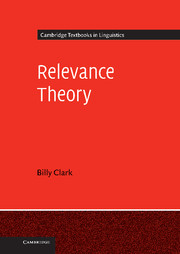Book contents
- Frontmatter
- Contents
- List of Figures and tables
- Preface
- Acknowledgements
- Typographical conventions
- Part I Overview
- Part II Details and developments
- 5 Explicature and implicature
- 6 Types of explicature
- 7 Types of implicature
- 8 Lexical pragmatics
- 9 Figurative language: metaphor
- 10 Figurative language: irony
- 11 Linguistic semantics
- 12 Conclusion: applications and recent developments
- Appendix Key notions of relevance theory
- Notes to chapters
- Bibliography and other resources
- Index
5 - Explicature and implicature
from Part II - Details and developments
Published online by Cambridge University Press: 05 June 2013
- Frontmatter
- Contents
- List of Figures and tables
- Preface
- Acknowledgements
- Typographical conventions
- Part I Overview
- Part II Details and developments
- 5 Explicature and implicature
- 6 Types of explicature
- 7 Types of implicature
- 8 Lexical pragmatics
- 9 Figurative language: metaphor
- 10 Figurative language: irony
- 11 Linguistic semantics
- 12 Conclusion: applications and recent developments
- Appendix Key notions of relevance theory
- Notes to chapters
- Bibliography and other resources
- Index
Summary
Topics: explicit and implicit communication; saying and implicating; the pragmatics of saying; explicature and implicature; alternative approaches
Overview
One of the key differences between relevance theory and Grice's approach lies in the way that relevance theory sees the distinction between explicit and implicit communication. In common with several other post-Gricean approaches, relevance theory emphasises that pragmatics plays an important role in determining (what Grice would have called) ‘what is said’ by a communicator. As well as this, the distinction between ‘what is said’ and ‘what is implicated’ is replaced within relevance theory by a distinction between explicature and implicature. This chapter explores the new distinctions proposed within relevance theory. It begins with a reminder of Grice's distinction between saying and implicating, and how he drew the distinction between semantics and pragmatics. It then explores some of the problems with Grice's way of drawing these two distinctions and the motivation for the development of the notion of explicature. It spells out how relevance theory distinguishes between explicature and implicature and explores some of the problems in coming up with a definitive way of drawing the distinction. Finally, it considers some alternative ways of accounting for the distinction between explicit and implicit communication.
- Type
- Chapter
- Information
- Relevance Theory , pp. 159 - 199Publisher: Cambridge University PressPrint publication year: 2013



